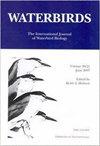Trophic Interactions of Shorebirds in a Wintering Area of Southern Brazil: Foraging Strategies and Habitat Preferences
IF 0.6
4区 生物学
Q3 ORNITHOLOGY
引用次数: 0
Abstract
Abstract. In wintering shorebird communities, interspecific niche segregation can occur by differences in diet, behavior, and morphology. The Lagoa do Peixe National Park (LPNP) is a coastal wetland complex with lagoons and sandy beaches in Southern Brazil, providing an environment with high prey availability where mixed-species foraging flocks of the Sanderling Calidris alba and the White-rumped Sandpiper Calidris fuscicollis occur. We counted all individuals in flocks and observed a higher proportion of Sanderlings than White-rumped Sandpipers foraging in the intertidal zone. To describe and evaluate patterns of trophic interactions between the two species, we built ethograms using video recordings and analyzed the foraging techniques and microhabitats used by individuals. The White-rumped Sandpiper (n = 45) was sighted foraging both in the supralittoral (n = 14) and intertidal zone (n = 31), whereas the Sanderling (n = 46) mostly foraged in the intertidal zone (n = 44). We estimated niche measures from foraging strategies and habitat preferences, which together can indicate dietary specialization. While niche width was similar for the two species, niche overlap was not significant, probably due to the different foraging microhabitats and techniques used by these two species. Therefore, the LPNP ecosystem offers diverse opportunities for wintering shorebirds, and is the southernmost area in which niche estimates of the Sanderling were assessed.巴西南部越冬区滨鸟的营养相互作用:觅食策略和栖息地偏好
摘要在越冬滨鸟群落中,种间生态位分离可由饮食、行为和形态的差异引起。Lagoa do Peixe国家公园(LPNP)是巴西南部一个拥有泻湖和沙滩的沿海湿地综合体,提供了一个高猎物可得性的环境,在这里出现了混合物种觅食群的Sanderling Calidris alba和白背矶鹞Calidris fuscicollis。我们以群为单位对所有个体进行了统计,发现在潮间带觅食的三脚鹬比白臀矶鹬的比例更高。为了描述和评估两种物种之间的营养相互作用模式,我们利用视频记录建立了族谱,并分析了个体的觅食技术和微栖息地。白腹矶鹬(n = 45)在潮间带(n = 31)和潮上带(n = 14)均有觅食,沙蚤(n = 46)主要在潮间带(n = 44)觅食。我们从觅食策略和栖息地偏好中估计了生态位措施,它们共同表明了饮食专业化。两种物种的生态位宽度相似,但生态位重叠不显著,这可能是由于两种物种的觅食微生境和使用的技术不同所致。因此,LPNP生态系统为越冬滨鸟提供了多种机会,并且是最南端的地区,对Sanderling的生态位进行了评估。
本文章由计算机程序翻译,如有差异,请以英文原文为准。
求助全文
约1分钟内获得全文
求助全文
来源期刊

Waterbirds
生物-鸟类学
CiteScore
1.30
自引率
0.00%
发文量
0
审稿时长
6-12 weeks
期刊介绍:
Waterbirds is an international scientific journal of the Waterbird Society. The journal is published four times a year (March, June, September and December) and specializes in the biology, abundance, ecology, management and conservation of all waterbird species living in marine, estuarine and freshwater habitats. Waterbirds welcomes submission of scientific articles and notes containing the results of original studies worldwide, unsolicited critical commentary and reviews of appropriate topics.
 求助内容:
求助内容: 应助结果提醒方式:
应助结果提醒方式:


